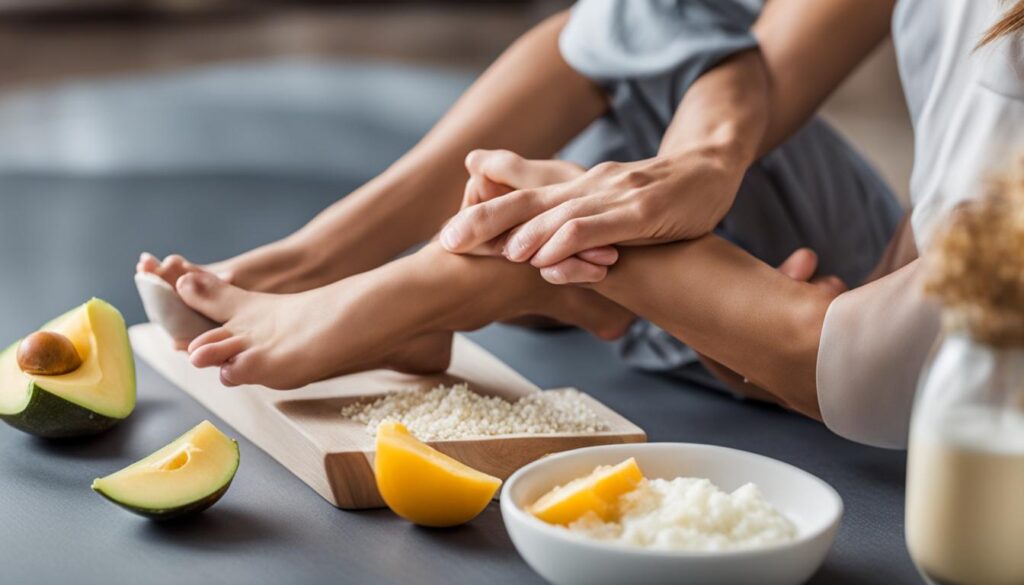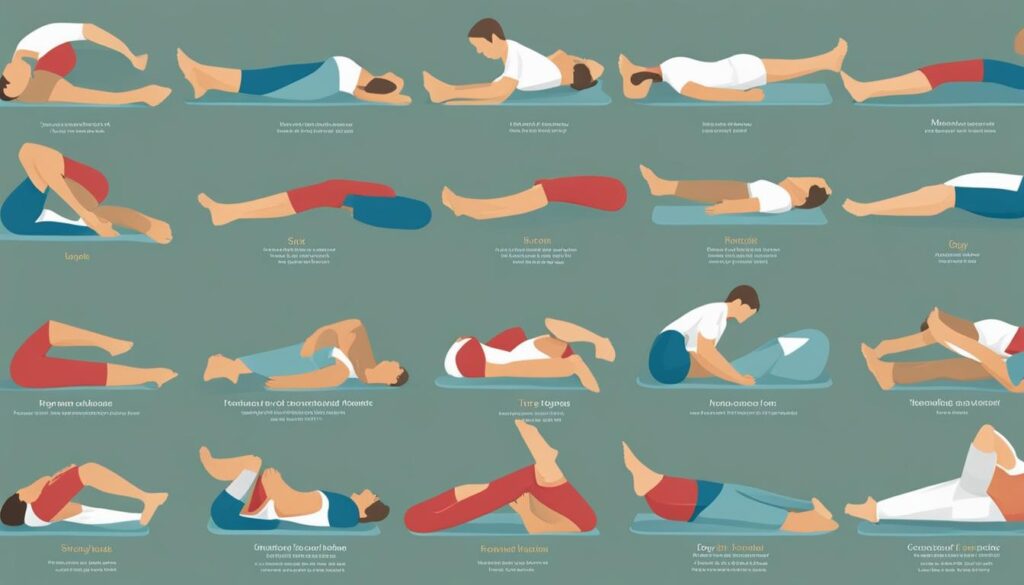Nothing halts a peaceful moment faster than the sudden onset of a toe cramp. Whether it’s during a yoga session or in the middle of the night, the tightening, twisting pain can be intensely uncomfortable. Shortly, we will delve into the world of preventing toe cramps, exploring various causes, symptoms, and natural remedies for toe cramps. We aim to provide you with a range of helpful insights and strategies for toe cramps prevention that can be easily integrated into your daily routine.
Let’s start with some crucial takeaways to bear in mind as you continue empowering yourself on this journey to prevent and manage toe cramps effectively.
Key Takeaways
- Understanding the underlying causes of toe cramps can be instrumental in preventing them.
- Stay hydrated as dehydration can lead to muscle cramps, including those in your toes.
- Maintaining a balanced diet rich in essential minerals such as potassium, magnesium, and calcium can help prevent toe cramps.
- Regular physical activity and muscle stretching can alleviate and prevent toe cramps.
- Wearing well-fitting, supportive footwear contributes significantly to preventing toe cramps.
- Over-the-counter medications can provide temporary relief, but persistent or severe toe cramps may require medical consultation.
Understanding Toe Cramps
To manage toe cramps effectively, a fundamental understanding of their causes is vital.
Toe cramps, characterized by spasms or contractions of the small muscles in the foot, can be caused by a myriad of factors. These include tight or weak muscles, muscle injuries, dehydration, electrolyte imbalances, nerve damage, poor blood flow, arthritis, and conditions that result in involuntary muscle contractions. Furthermore, infections and organ failure can also compromise muscle control and lead to such discomfort.
“Knowledge of these underlying causes is essential in learning how to prevent toe cramps effectively.”
Here’s a brief table for better comprehension:
| Cause | Description |
|---|---|
| Muscle tightness/weakness | Overexertion of muscles or lack of regular exercise leads to muscle weakness or tightness which can lead to toe cramps. |
| Dehydration/Electrolyte Imbalance | Lack of fluids or imbalances in the body’s electrolytes can cause muscle cramps, including those of the toes. |
| Nerve Damage | Damage to the nerves can affect communication with the muscles, leading to involuntary contractions and cramping. |
| Poor Blood Flow | Insufficient blood flow to the feet can cause the muscles in your toes to cramp. |
| Arthritis | Arthritis causes pain and inflammation in the joints, which can lead to cramping in the toes. |
| Other Health Conditions | Some health conditions can cause involuntary muscle contractions, leading to cramps. These include infections and organ failure. |
Toe cramps may not be life-threatening, but they can significantly reduce your quality of life. By understanding their causes, you put yourself in a better position to control and manage this discomfort.
Key Factors Contributing to Toe Cramps
While it’s clear that toe cramps can be quite discomforting, it’s essential to understand that various factors can precipitate these cramps. By exploring these factors, we can find out how to effectively relieve toe cramps, avoid toe cramps, and even prevent toe cramps at night.
Dehydration and Electrolyte Imbalance
Dehydration is a leading factor that can precipitate toe cramps. It can lead to muscle tension and cramping, especially if the muscles are overstressed or injured. Alongside dehydration, electrolyte imbalances, such as low levels of calcium, can provoke muscle spasms and cramps.
Inadequate Footwear: A Culprit of Toe Cramps
Inadequate footwear, including high heels, tight shoes, or any footwear that puts pressure on the toes, can initiate toe cramps by forcing the toes into unnatural positions and causing muscle strain. Using appropriate, well-fitting shoes is essential to avoid toe cramps by preventing unnecessary pressure and supporting healthy foot mechanics.
Impact of Muscle Overuse and Sedentary Lifestyles
Muscular overuse from excessive physical activity can lead to toe cramps. New exercise routines or overexertion can often result in muscle tension or weakness, making cramps more likely to occur. Conversely, leading a sedentary lifestyle without adequate stretching may also contribute to muscle tension. However, this can be countered by regular, light exercises to help strengthen the muscles and promote excellent outcomes to prevent toe cramps at night.
| Factor | Consequence | Prevention |
|---|---|---|
| Dehydration | Muscle tension leading to cramps | Regular intake of water |
| Electrolyte imbalance | Muscle spasms and cramps | Ensure a balanced diet rich in minerals |
| Inadequate footwear | Unnatural positions causing muscle strain | Fitting and comfortable shoes |
| Muscle overuse/Sedentary lifestyle | Muscle tension/weakness making cramps likely | Regular, light exercises and adequate stretching |
Together, these factors provide us with insights on relieving toe cramps, preventing toe cramps, and some valuable tips for avoiding toe cramps. In our endeavor for healthy feet, addressing these factors effectively can prove to be the decisive game-changer.
Preventing Toe Cramps
When it comes to addressing foot discomfort like toe cramps, preventive measures take center stage. These interventions pave the way for healthier foot mechanics, reducing the chances of experiencing these agonizing spasms. This section provides key insights on how to prevent toe cramps, offering valuable practices that can be easily inculcated in your daily routines.
Exercises to prevent toe cramps are an integral part of this preventive measure. Daily stretching of the foot and toe muscles is a simple yet effective strategy that can markedly decrease the recurrence of cramps. Regular physical activity also plays a pivotal role, especially for individuals with predominantly sedentary lifestyles. Taking frequent walking breaks can keep the foot muscles engaged and better prepared to handle spurts of increased pressure or activity.
Remember, the objective is to develop routines that contribute towards sustaining foot health and comfort. Hence, attempting to incorporate these interventions before the onset or escalation of cramps is advisable.
Furthermore, the importance of wearing supportive shoes that fit well cannot be overstated. Ill-fitting, constraining footwear can oftentimes be the underlying cause of cramps, pushing your toes into uncomfortable positions, and straining the muscles. Therefore, investing in good quality, comfortable shoes is a significant step towards avoiding such discomfort at the outset.
Addressing any existing medical conditions is another critical aspect investigated in the quest of preventing toe cramps at night or any other time. Underlying pathologies can foster an environment conducive for the manifestation of toe cramps. Thus, adhering to prescribed treatments and addressing these medical factors expediently is quintessential.
| Preventive Measure | Description |
|---|---|
| Daily Foot and Toe Stretching | Regular stretching of foot and toe muscles aids in keeping them flexible and less prone to cramping. |
| Frequent Walking Breaks | Taking regular breaks from sedentary positions to walk around plays a beneficial role in preventing toe cramps. |
| Supportive Footwear | Investing in comfortable, well-fitting shoes supports healthier foot mechanics, reducing the chances of toe cramping. |
| Addressing Existing Medical Conditions | Appropriately managing underlying medical conditions can greatly minimize any provoked toe cramp episodes. |
Remember, prevention is indeed better than cure, and understanding the root causes of toe cramps is the foundation that the prevention strategies are built upon. By integrating these simple practices into your daily routine, you can significantly minimize the chances of experiencing any toe cramps, thereby ensuring a smoother stride through life!
Simple Stretching Exercises for Relief
Engaging in easy, at-home exercises can be an effective way to relieve toe cramps and strengthen foot muscles. The following exercises are beneficial to prevent toe cramps and can conveniently be completed without requiring a trip to the gym.

The Towel Stretch
Popular for being a quick-natural remedy for toe cramps, the towel stretch requires only a towel, making it convenient for most. This stretch can help alleviate discomfort often associated with bouts of toe cramps.
- Sit on the floor and extend your legs in front of you.
- Wrap a towel around the top of the foot, holding each end in your hands.
- Gently pull the towel towards you, until you feel a stretch in the back of your lower leg and bottom of your foot.
- Hold this position for 15-30 seconds and release. Repeat five times.
Toe Raises and Curls for Muscle Strengthening
Regularly performing toe raises and curls can help fortify the muscles in your feet, potentially contributing to a decline in the frequency of toe cramps.
- Toe Raise: Stand straight and slowly lift your heels off the ground, raising your body onto the balls of your feet. Lower your body back down and repeat ten times.
- Toe Curl: Sit comfortably with your feet flat on the ground. Curl your toes as if picking up a small object from the floor. Relax and repeat ten times.
Marble Pickup: A Foot Flexibility Exercise
Though it may seem like an unconventional exercise, the marble pickup exercise is an excellent technique to enhance foot flexibility and condition the muscles, helping to prevent toe cramps.
- Place a couple of marbles on the floor.
- Using only your toes, try picking up one marble at a time.
- Repeat this action until you’ve picked up all the marbles.
Natural Remedies and Home Treatments
In the journey to relieve toe cramps, there are several natural remedies and home treatments that can prove to be beneficial. These solutions may provide immediate relief and might be especially useful for those who experience frequent cramping episodes.
Heat application is a traditional treatment for muscle cramps and can be particularly effective for toe cramps. Soaking your feet in warm water or using a heating pad can bring immediate relief.
Massage is another effective home treatment for toe cramps. Regularly massaging the feet can help improve blood circulation and relax tight muscles, reducing the intensity and frequency of cramping.
- Gentle finger and thumb pressure
- Use of a foot roller or ball
- Stretching the toes and flexing the foot
Using a cold pack is another effective remedy. The cold temperature can help numb the feelings of pain and reduce inflammation, offering some relief.
Nonsteroidal anti-inflammatory drugs (NSAIDs), available over the counter, can also be used to alleviate the discomfort from muscle injuries that may be causing toe cramps. Consultation with a healthcare provider is needed before starting any medication.
Note: While these remedies can offer temporary relief, they may not address the root cause of recurring or persistent toe cramps. Professional medical advice is suggested if cramps continue to be a recurring issue.
Lifestyle and Dietary Considerations
Adopting a holistic approach to foot health can assist greatly in toe cramp prevention. This involves not merely quick fixes or remedies, but venturing into substantial lifestyle and dietary alterations. Three primary considerations in adopting this approach include hydration, balanced nutrient intake, and the judicious choice of footwear.
Hydration: A Key Factor in Cramp Prevention
One significant factor in muscle health is staying well-hydrated. Dehydration can be a trigger for toe cramps, especially in warmer or more physically active periods. Regular water intake can help avoid toe cramps by ensuring the muscles remain hydrated and less prone to spasming.
Importance of Balanced Nutrient Intake
Besides hydration, proper nutrition plays a vital role in fending off unwanted muscle contractions. Deficiencies in critical minerals such as calcium, magnesium, and potassium may cause muscle cramps. A balanced diet rich in mineral-heavy foods like spinach, almonds, bananas, and yogurt can be a simple yet effective measure in your catalog of tips for avoiding toe cramps.
The Role of Supportive Footwear in Toe Health
Lastly, the choice of footwear can have a profound effect on toe health. Shoes that offer extensive support and fit well contribute to avoiding discomfort, like toe cramps. On the other hand, restrictive or painfully tight footwear can exacerbate toe cramp issues. It is advisable to choose options that have roomy toe boxes and conform to your foot’s natural alignment to prevent toe cramps effectively.

To prevent toe cramps at night, these lifestyle and dietary modifications ought to be combined with regular light exercise and stretching routines designed to strengthen the foot muscles. Adopting such practices can help create a holistic approach in symptom management, specifically in the natural prevention of toe cramps.
When to Seek Medical Attention
Managing toe cramps effectively largely depends on the severity, duration, and accompanying symptoms of the cramps. It is crucial to pay attention to these factors and understand when it’s necessary to seek professional medical attention.
Persistent or excruciating toe cramps, especially those accompanied by signs of infection, may indicate underlying more serious health conditions, such as diabetes or kidney failure, and warrant immediate medical attention.
“Seek professional advice if toe cramps do not improve with at-home treatments and exercises, persist for more than a week, or are accompanied by symptoms such as foot swelling, discoloration, or numbness.”
- Toe cramps lasting more than a week
- Persistent swelling or numbness of the foot
- Discoloration of the foot
- The presence of signs of infection or other symptoms
Performing exercises to prevent toe cramps regularly can help manage and alleviate the discomfort. However, in case of severe and persistent symptoms, it’s always wise to consult a healthcare professional.
Conclusion
In the quest on how to prevent toe cramps and embrace a lifestyle devoid of any unwanted foot discomfort, there are several measures to uphold. These include regular stretching, staying hydrated, ensuring a well-rounded diet, and wearing comfortable footwear. Let’s delve a little deeper into each of these practices.
Key Takeaways for Preventing Toe Cramps
Regular stretching and light exercises keep your feet and toes agile, well-toned, and less prone to cramping. Adequate hydration is another pillar in toe cramp prevention. It aids in maintaining optimal muscle function, thus helping to avoid toe cramps. Ensuring a balanced diet, rich in essential minerals, helps prevent muscle contractions originating from nutrient deficiencies. Crucially, always opt for supportive footwear that promotes natural foot alignment and minimizes muscle strain.
Establishing a Proactive Approach
Moving forward, adopting a proactive approach to foot health can significantly mitigate the risk of developing toe cramps. This involves understanding the potential triggers, implementing preventive tactics, and not hesitating to seek medical intervention when needed. By doing so, you set the stage for a lifestyle that is conducive to healthful, pain-free movement – be it during the day, or to prevent toe cramps at night.
Remember, the path to a pain-free life requires consistency in these practices. Adopt these tips for avoiding toe cramps and enjoy the comfort of an untroubled stride.





